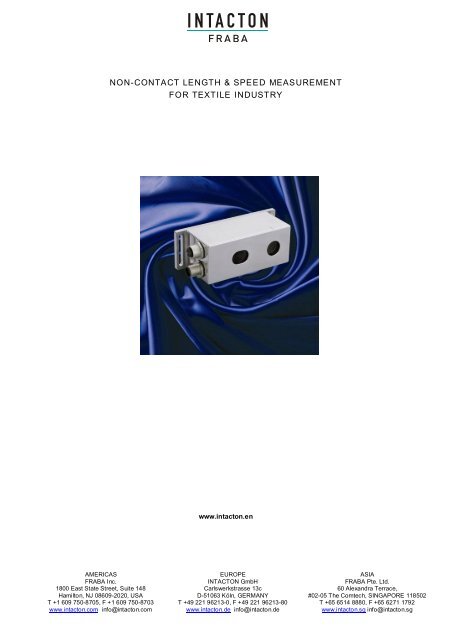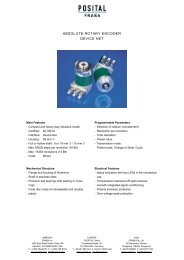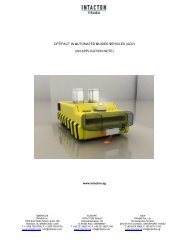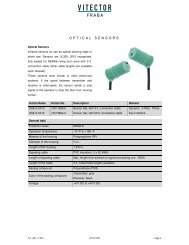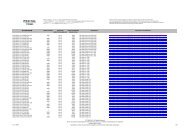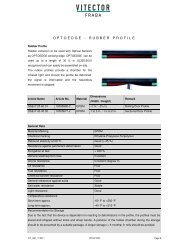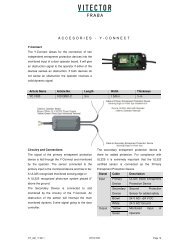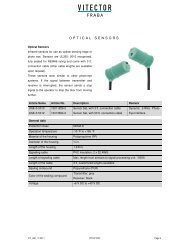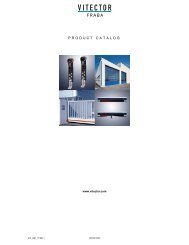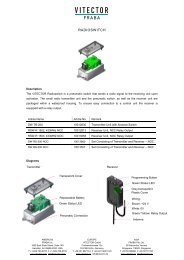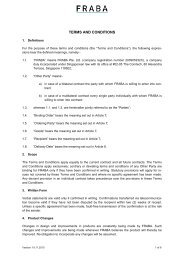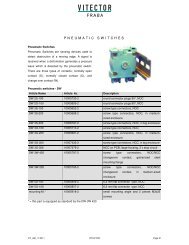Absolute Winkelcodierer OCD Powerlink
Absolute Winkelcodierer OCD Powerlink
Absolute Winkelcodierer OCD Powerlink
You also want an ePaper? Increase the reach of your titles
YUMPU automatically turns print PDFs into web optimized ePapers that Google loves.
AMERICAS<br />
FRABA Inc.<br />
1800 East State Street, Suite 148<br />
Hamilton, NJ 08609-2020, USA<br />
T +1 609 750-8705, F +1 609 750-8703<br />
www.intacton.com info@intacton.com<br />
NON-CONTACT LENGTH & SPEED MEASUREMENT<br />
FOR TEXTILE INDUSTRY<br />
www.intacton.en<br />
EUROPE<br />
INTACTON GmbH<br />
Carlswerkstrasse 13c<br />
D-51063 Köln, GERMANY<br />
T +49 221 96213-0, F +49 221 96213-80<br />
www.intacton.de info@intacton.de<br />
ASIA<br />
FRABA Pte. Ltd.<br />
60 Alexandra Terrace,<br />
#02-05 The Comtech, SINGAPORE 118502<br />
T +65 6514 8880, F +65 6271 1792<br />
www.intacton.sg info@intacton.sg
Background<br />
Length and speed are two essential measurement<br />
parameters which are prominent in textile indus-<br />
tries worldwide. For optimal quality at textile print-<br />
ing, cutting, textile power loom and spinning mill<br />
processes, the accurate determination of these<br />
parameters is required, to avoid wastage and<br />
meanwhile minimize the production costs.<br />
The commonly used solutions, like measurement<br />
wheels combined with incremental encoders bring<br />
forth many problems. One of the biggest problems<br />
for achieving ideal process control is slippage in<br />
measurements. This leads to significant measure-<br />
ment errors in for example, cutting applications.<br />
Furthermore, the contact measuring principle has<br />
the risk of surface contamination and often leaves<br />
unwanted residue and marks on the textile’s sur-<br />
faces.<br />
Hence, the use of such conventional systems is<br />
limited and is considered unsuitable for use over<br />
sensitive surfaces. Furthermore, these convention-<br />
al measurement systems need to be constantly<br />
monitored and hence increasing installation and<br />
maintenance costs manifold.<br />
Optical Alternative<br />
The two non-contact sensors, COVIDIS and OP-<br />
TIPACT, offer an optical alternative through slip<br />
free accurate length and velocity measurement.<br />
These sensors are specially designed for applica-<br />
tions where feed- motion, length, velocity or differ-<br />
ences requires measurement. Due to the non-<br />
contact technology, they are ideally suited for<br />
measuring applications in the textile industry,<br />
where measurements are of fine and sensitive<br />
materials.<br />
Typical Applications<br />
A broad and diverse range of applications in the<br />
textile industry are covered by two non-contact<br />
sensors, COVIDIS and OPTIPACT. COVIDIS is a<br />
high-end sensor, with a measurement uncertainty<br />
of less than 0.05%. It is especially suitable for very<br />
fast moving applications (up to 50 m/s) requiring<br />
high precision. OPTIPACT sensors are available<br />
with different configurations depending on the<br />
surface and speed of the measurand. They are<br />
used in applications with slower travelling speeds<br />
(up to 4 m/s) and are used as smart 2- Axis mea-<br />
surement sensors. This is a one of a kind, low cost<br />
sensor, which provides contact free 2 dimensional<br />
measurements and can be used to directly replace<br />
encoders with measuring wheels.<br />
Page 2 Textile Applications Version 1.0<br />
06/2011
Measurement of inlet speed<br />
SANFOR® Process – Measurement Issues<br />
Pressure<br />
Zone<br />
SANFOR® Process is the defined shrinking<br />
process in textiles and cotton before use. The<br />
initial process includes moistening the material and<br />
passing of textile into the pressure zone, where it<br />
is heated and stretched. After leaving the pressure<br />
zone, the fabric is sent through rollers to remove<br />
the moisture. This in turn, shrinks the fabric. A<br />
regulated shrinking process ensures consistent<br />
quality. This quality is determined by the inlet and<br />
outlet velocity of the textile, in and out of the pres-<br />
sure zone. The exact knowledge of these parame-<br />
ters is essential for process control.<br />
SANFOR® Process – Optical Alternative<br />
INTACTON presents the possibility of a precise<br />
non-contact optical velocity measurement without<br />
errors caused by slippage. Therefore no contami-<br />
nation or marks are left on the sensitive surface.<br />
Furthermore a two dimensional measurement can<br />
be performed. Thereby not only the velocity of feed<br />
but also elongation or deformation of the material<br />
can be detected. An over speed can be signaled<br />
by digital outputs, where the maximum speed is<br />
adjustable. Furthermore, the quality of measure-<br />
ment can be monitored by the diagnostic outputs.<br />
Thus, the shrinkage can be optimally adjusted<br />
using the accurate measurement feedback to en-<br />
sure a reproducible quality of the material.<br />
Measurement of outlet speed<br />
Textile Coating & Dyeing –Measurement Issues<br />
Textile coating and dyeing machinery often involve<br />
several textile finishing and lamination stages. In<br />
such applications the properties of the textile are<br />
changed in terms of water / chemical / light resis-<br />
tance or surface design. During the process sever-<br />
al coatings run over each other. Dimensional<br />
changes in terms of linear expansion and deforma-<br />
tion of the material require dynamic measurements<br />
to be done. The use of conventional measurement<br />
systems are unable to do so, and will lead to a loss<br />
of quality owing to measurement errors. This appli-<br />
cation in particular requires a feed speed control<br />
and a targeted re-adjustment for pre-defined<br />
process control.<br />
Textile Coating & Dyeing – Optical Alternative<br />
INTACTON’s optical motion sensors are designed<br />
for non-contact, optical, speed and length mea-<br />
surement in 2 dimensions even under varying<br />
measurement conditions. The sensors can work<br />
even under deviation of working distance and<br />
varying image rates (anything above the minimum<br />
requirement). The 2D measurement is also helpful<br />
in detecting any deformations and can enable the<br />
user to adjust the control parameters accordingly.<br />
Suffice to say. OPTIPACT and COVIDIS are con-<br />
venient solutions for speed control, length mea-<br />
surement and deformation indication in textile<br />
coating applications.<br />
Page 3 Textile Applications Version 1.0<br />
06/2011
Measurement in 2-D<br />
Textile Cutting and Printing – Measurement<br />
Issues<br />
Textile cutting and printing processes require accu-<br />
rate length measurement for precise cutting and<br />
design of the fabric, in order to, minimize the was-<br />
tage and therefore reduce the material costs. For<br />
defined stacking and cutting processes a precise<br />
measurement of these parameters is always re-<br />
quired. The slippage in conventional measurement<br />
tools involving wheels and incremental encoder is<br />
a major hindrance in such machinery. Furthermore<br />
velocity variations particularly during roll changing<br />
processes, often leads to measurement errors. The<br />
possibility of a constant speed control or detection<br />
of over speed will also be required.<br />
Textile Cutting and Printing – Optical Alterna-<br />
tive<br />
The optical non-contact principle once again<br />
comes into operation. Such consistent and accu-<br />
rate measurement feedback enables the control<br />
system to define a steady process control, to re-<br />
duce material wastage and ultimately minimize the<br />
production costs. The digital outputs can be used<br />
to detect any over speed in the fabric feed or sig-<br />
nal a pre-determined length. Since all the sensors<br />
can detect standstill in both forward and backward<br />
directions it makes the measurement system even<br />
more flexible.<br />
Spinning Mills and Power loom– Measurement<br />
Issues<br />
In spinning mills and textile power looms the<br />
supply and outlet speed of yarn, thread and fabric<br />
are continuously monitored. The machinery re-<br />
quires long range length and high velocity mea-<br />
surements. The conventionally used measurement<br />
systems often endanger the production and cause<br />
a lot of material wastage because of improper<br />
measurements due to variations in measurement<br />
conditions and constraints on length and velocity<br />
measurements. Machinery with measurement<br />
wheels suffered the most with very high errors due<br />
to slippage and high rate of textile deformation and<br />
wastage.<br />
Spinning Mills and Power loom– Optical Alter-<br />
native<br />
The non-contact optical measurement sensors<br />
from INTACTON are ideal for usage in spinning<br />
mills and power looms as they provide accurate<br />
measurements without causing any textile defor-<br />
mation or high material wastage. Moreover, COVI-<br />
DIS is already proved in this application and can<br />
measure high speeds of thread up to 50m/s with<br />
measurement uncertainties ≤ 0.05%. The mea-<br />
surement range of length is infinite and the sen-<br />
sors can measure over diverse range of textile<br />
materials leading to considerable cost savings.<br />
Page 4 Textile Applications Version 1.0<br />
06/2011
OPTIPACT<br />
Small, Flexible, Low Cost Units<br />
OPTIPACT sensors consist of an LED illumination<br />
unit, a 2D camera, miniaturized transmitting and<br />
receiving optics, and integrated analysis and inter-<br />
face electronics. With a size of 98 x 42 x 47 mm<br />
and weighing only 250 grams, the units can be<br />
easily integrated into almost any application. X-<br />
axis and Y-axis position data enable surveillance<br />
of movement in any direction – unlike in other<br />
systems, adjustment and calibration is not re-<br />
quired. The sensors are housed in an IP65-<br />
protected aluminum enclosure. They require a<br />
supply voltage of optionally +5 or 10…30 V. An<br />
incremental interface and an RS232 interface are<br />
available for communication with a higher-level<br />
PLC. INTACTON implements field bus systems or<br />
SSI on request. The sensors’ completely modular<br />
design enables easy adaptation to various specific<br />
requirements. The energy-efficient LED illumina-<br />
tion has the added advantage of requiring no ex-<br />
ternal illumination and hence less repair and ser-<br />
vice costs. Furthermore, unlike conventional optical<br />
systems, the OPTIPACT sensor is completely<br />
maintenance-free.<br />
Function principle<br />
The OPTIPACT system uses a very simple non-<br />
contact, slippage free measurement principle. It is<br />
basically a simple correlation method whereby the<br />
surface is observed by an area camera suitably<br />
illuminated by appropriate light sources. Displace-<br />
ment, direction and velocity are analyzed and<br />
calculated by comparing consecutive high resolu-<br />
tion surface pictures. Image correlation relies on<br />
image overlaps within a captured sequence of<br />
images. With increasing speed the overlap is re-<br />
duced. In consequence, the maximum detectable<br />
velocity depends on the optics design limiting the<br />
size of the field of view of the camera. This para-<br />
meter simultaneously influences the structures<br />
visible on the image, the essential basis of the<br />
image correlation calculations. The OPTIPACT<br />
sensors has different models, OPT-S/F/M, varying<br />
in the design of optics and therefore in the optical<br />
resolution. The optics of OPT-S was designed for<br />
velocities up to 4m/s. The optics of OPT-F has a<br />
four-time higher magnification, thereby the velocity<br />
range decrease to 1m/s, but enables measurement<br />
on fine structured surfaces.<br />
Page 5 Textile Applications Version 1.0<br />
06/2011
COVIDIS<br />
High Precision Measurement<br />
The core of the COVIDIS sensor system is a high<br />
speed line camera that detects light reflected from<br />
the object being measured. The basic measure-<br />
ment principle is based on further refinement of the<br />
tried-and-tested spatial frequency filtering technol-<br />
ogy. A grid structure is superimposed over the<br />
moving camera image, thus allowing a periodic<br />
output signal to be obtained, with a frequency<br />
proportional to the velocity. Using a time-related<br />
integration of the velocity signal, the distance cov-<br />
ered can be measured with an accuracy of 0.05%.<br />
The analysis of the data is achieved by advanced<br />
algorithm running on a powerful data processing<br />
platform. These sensor systems thus show a high<br />
degree of adaptability and can be used on a wide<br />
range of industrial surfaces. It is even possible to<br />
detect lack of motion or direction change in the<br />
object being measured, which is then taken into<br />
account in the measurement of distance covered.<br />
Using LED´s, an RS232 interface, and appropriate<br />
software, extensive configuration and diagnostic<br />
possibilities are available for users, thus facilitating<br />
the starting of operations as well as enabling pre-<br />
ventive maintenance.<br />
Measurand<br />
LED Illumination<br />
High Speed Camera<br />
Page 6 Textile Applications Version 1.0<br />
Lens<br />
FPGA/DSP Platform<br />
Material friendly, Maintenance-free Solution<br />
The main advantage of non-contact measurement<br />
solution above all factors is the reduced<br />
measurement error due to the lack of slippage and<br />
dynamic measurement capabilities. This blend of<br />
characteristics also minimizes costs. Furthermore,<br />
due to the non-contact principle, the surface under<br />
measurement is not damaged by pressure, which<br />
is especially important for sensitive materials.<br />
Effective process control is possible through<br />
numerous features like precise position and<br />
velocity feedback, detection of abnormal velocity<br />
through digital outputs, and quality of<br />
measurements through diagnostic outputs. The<br />
compact design enables a hassle free installation<br />
of the sensor even in places with constrained<br />
space and difficult access. In addition to the<br />
compact design, the simple graphical user<br />
interface provides an ideal solution for easy startup<br />
and operation of the sensor. The sensors require<br />
no mechanical connection and thus provide a<br />
reliable, maintenance-free and precise solution for<br />
effective measurements over a varied range of<br />
materials and providing ideal sensing solutions for<br />
effective quality control of a variety of processes.<br />
06/2011
Characteristics<br />
COVIDIS OPTIPACT-S OPTIPACT-F OPTIPACT-M<br />
Velocity Range ± 50 m/s ± 4 m/s ± 1 m/s ± 2,5 m/s<br />
Working Distance 300mm ±5% 40mm ±10% 15mm ±10% 180mm ±3%<br />
Measurement Uncertainty
INTACTON GmbH<br />
INTACTON GmbH was founded in 2004 as a<br />
FRABA Group enterprise. Based in Cologne, we<br />
develop, manufacture and distribute optical motion<br />
sensors for measurement of lengths and velocity.<br />
Since 2006, INTACTON has been establishing and<br />
extending a network of national and foreign distrib-<br />
utors that, even when far away from the firm’s<br />
headquarters, ensures competence in consultation<br />
in the local language. Manufacturers and users of<br />
production machines, textile manufacturers as well<br />
as companies in the fields of lift technology or<br />
special-purpose vehicles constitute the main cus-<br />
tomers of INTACTON.<br />
AMERICAS<br />
FRABA Inc.<br />
1800 East State Street, Suite 148<br />
Hamilton, NJ 08609-2020, USA<br />
T +1 609 750-8705, F +1 609 750-8703<br />
www.intacton.com info@intacton.com<br />
FRABA Group<br />
FRABA Group today comprises a set of companies<br />
focused on niches in the industrial automation<br />
market. The company was founded in Cologne,<br />
Germany in 1918 and initially manufactured relays<br />
in serial production. This focus was maintained<br />
until the mid sixties and provided the basis for<br />
entry into the control market, and over 13,000<br />
machine controls were installed. In the seventies,<br />
FRABA was the pioneer in developing the market<br />
for rotary absolute optical encoders. Today the<br />
subsidiary POSITAL develops and markets these<br />
sensors as well as inclination sensors. Since the<br />
90's, the subsidiary VITECTOR has become one of<br />
the leading manufacturers of safety sensors for<br />
doors and gates.<br />
EUROPE<br />
INTACTON GmbH<br />
Carlswerkstrasse 13c<br />
D-51063 Köln, GERMANY<br />
T +49 221 96213-0, F +49 221 96213-80<br />
www.intacton.de info@intacton.de<br />
ASIA<br />
FRABA Pte. Ltd.<br />
60 Alexandra Terrace,<br />
#02-05 The Comtech, SINGAPORE 118502<br />
T +65 6514 8880, F +65 6271 1792<br />
www.intacton.sg info@intacton.sg


